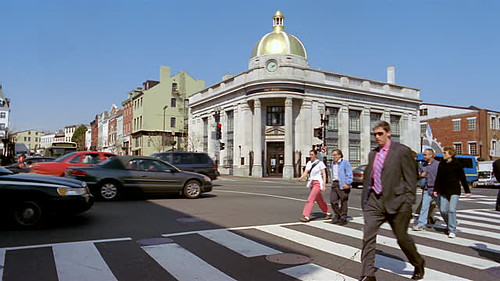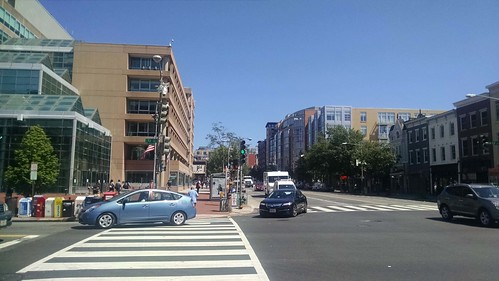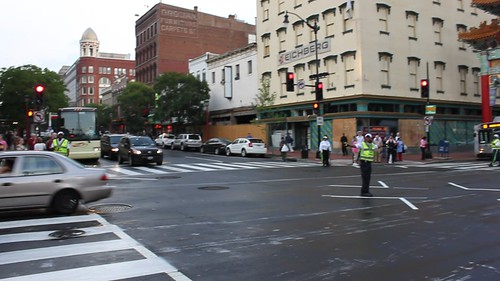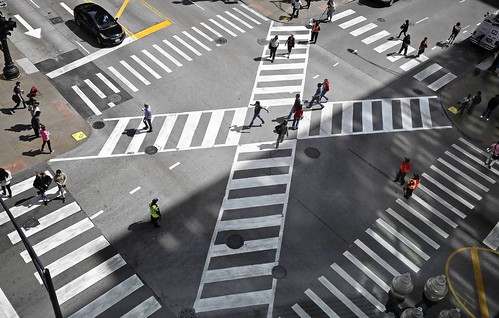Barnes Dance Intersections as possible "solutions" to Wisconsin & M, 14th and U intersections
Last week, the Current ran a story, "City studies dangerous intersections," about DC's five most "accident prone" intersections.
Because the Current covers the northwest quadrant of the city, the article focused on only two of the five intersections, Wisconsin Avenue and M Street NW--the "100% intersection" in Georgetown, and 14th and U Streets NW, a major crossroads intersection for its neighborhood.
According to the report High Crash Intersection Site Visits, produced at the prodding of Councilmember Mary Cheh, who chairs the Council committee with oversight over transportation matters, the other intersections are 1st Street and Massachusetts Avenue NE, at Union Station, Minnesota Avenue and Benning Road NE, and New York Avenue and Bladensburg Road NE. (The primary problem at the latter two intersections are motor vehicle crashes.)
The two northwest quadrant intersections are major nodes in the bus transit network too serving Metrobus and DC Circulator routes, and Georgetown's sidewalks are particularly narrow for the amount of pedestrian traffic they carry.

Wisconsin Avenue and M Street NW intersection, Georgetown. Getty Images photo.

14th and U Streets NW. Photo by Two Coffee Cups Consulting.
These particular intersections are major nodes in the city's pedestrian network, but because of the high motor vehicle traffic, signal timing favors motor vehicle movement over pedestrians. The traffic signal settings are complicated with multiple cycles, and some where pedestrians may cross against the light, bollixing vehicle traffic.
Note that from observation I'd say that besides high pedestrian volumes for both, the major problem in Georgetown is that not enough time is allocated for pedestrian crossing, while at 14th and U, during the left turn phase from 14th Street NW pedestrians cross against the light.
The so called "Barnes Dance" or "pedestrian scramble" intersection is set up to devote one entire cycle in the signal series exclusively to pedestrians, and allows for crossing the intersection six ways--on each side of the box and diagonally.
To its credit the DDOT report suggests considering "Barnes Dance" intersection as an intervention worth considering for the two intersections. Interestingly, the Current article didn't mention the pedestrian scramble as an option for either intersection.
According to research ("The Relative Effectiveness of Pedestrian Safety Countermeasures at Urban Intersections — Lessons from a New York City Experience ") introduction of the pedestrian scramble intersection treatment has been associated with a 50% reduction in pedestrian-involved crashes.
DC has one intersection set up this way, at 7th and H Streets NW in Gallery Place/Chinatown ("D.C. tests new diagonal pedestrian crossing downtown," Washington Examiner).
But that intersection, in my opinion, doesn't have a special enough urban design treatment to denote its uniqueness.
This video by Andrew Bossi was made during the initial test phase, but the street markings aren't much different even today.

Barnes Dance intersections in other cities, such as Pasadena, do a better job with pavements and street markings that denote a rebalancing of street usage towards pedestrians.
If DC is to implement more pedestrian scramble intersections, the ante should be upped on the quality of the street markings so the intersections stand out as special nodes within the mobility network.

Note how this "pedestrian scramble" intersection at Colorado and Raymond Avenues in Pasadena has special faux brick treatments for each of the pedestrian pathways, including the two diagonal paths. Photo: Gina Ferazzi, Los Angeles Times.

Pedestrian scramble, Jackson Boulevard and State Street, Chicago. The intersection serves about 41,000 pedestrians and 21,000 vehicles each day. Photo: John J. Kim, Chicago Tribune.
Converting these two intersections to Barnes Dance--pedestrian scramble--intersections would go a long way towards better balancing pedestrian level of service with motor vehicle level of service and likely lead to a significant reduction in pedestrian-motor vehicle
==============
Treating 1st and Massachusetts NE and North Capitol and Massachusetts in combination. The primary problem at 1st and Massachusetts NE is lack of adequate time provided to pedestrian crossing--Barnes Dance doesn't work for that intersection because pedestrians are moving primarily across only two of the four sides to the intersection (across 1st Street to and from Union Station and across Massachusetts Avenue). Although the report did note some other complications.
I'd argue that the evaluation of this intersection fails in some respects, by not evaluating 1st and Massachusetts Avenue NE in concert with an evaluation of the intersection one block west, North Capitol Street and Massachusetts Avenue.
Problems at 1st Street are exacerbated by the queuing of motor vehicle traffic moving westbound on Massachusetts. Eliminating parking in the curb lane would facilitate motor vehicle (and bicycle) movement and likely reduce some of the driving stress that may contribute to accidents at 1st Street.
Furthermore, walking is uncomfortable on the south side of the block between North Capitol and 1st Street because the sidewalk width is inadequate and people also queue for buses in this space. Similarly, the sidewalk on east side of North Capitol next to the Post Office building up to G Street is exceptionally narrow considering the volume of pedestrian traffic and the placement of a bus stop on this block.
While not the right treatment for 1st Street, a Barnes Dance intersection ought to be considered for the North Capitol and Massachusetts intersection, which has issues similar to the 14th and U with signal cycles, exacerbated by narrow sidewalks relative to the pedestrian volume in some locations. (Interestingly, I complained to USPS about particularly narrow sidewalks on the North Capitol side of their building in 1992.)
Large pedestrian volumes crossing North Capitol lead to significant queuing of traffic waiting to turn right. But the exclusive right turn signal phase is made less efficient by pedestrians crossing North Capitol. But there are large volumes of pedestrians crossing Massachusetts Avenue as well. While all four sides of the intersection don't experience equal volume, a Barnes Dance intersection treatment still probably makes sense and should be considered.
Labels: car culture and automobility, public safety, traffic engineering, urban design/placemaking, Vision Zero



8 Comments:
RE: 14th. Yep it is the left turn. Plenty of time to cross but people don't want to wait. Lots of drunks too.
Georgetown might be an interesting case. I don't think it would work on 14th very well.
Banning left turns on both 14th and U might be easier. I'd move the circulator stops up on block to V.
great idea for both spots- the arrogance of car drivers is astounding and they need to be put in their place and acknowledge the pedestrian and people in the city other than just their own selfish needs / desires
in general all cities should prioritize services vehicles- emergency and workers who are essential to the running of a city or its general functions- and single vehicle passenger cars should be deemphasized instead of constantly accommodated and pandered to as we do now. basically the AAA runs most of the transportation policy and action made and practiced in the USA
I forgot to mention the PEDSAFE Countermeasures tool, which doesn't mention the pedestrian scramble. But the website admits that it doesn't include every countermeasure either.
http://pedbikesafe.org/
However, the ped. scramble was discussed in this document. It cites some previous studies that found a 50% reduction in crashes.
http://docs.trb.org/prp/12-3237.pdf
The study results in NYC (site of the test of 5 different countermeasures) also found a 51% reduction in ped-related crashes with the Barnes Dance.
Great reflection on these two intersections. I go through Wisconsin and M as a pedestrian a few times per month and it always strikes me as poorly designed, which is then exacerbated by too many SOVs using M St as a commuting route.
Can I ask for your reconsideration of the word "accident" in 7th-to-last paragraph? I've seen "crash" as the more pedestrian-friendly term and thought it would fit well with the theme of this article.
Always enjoy your posts. Thanks.
done. I added one paragraph on the research results too, rather than leaving it in the comments only.
you are traveling DC to New York, you have to travel through Bus as i got
Cheap Bus Tickets.
DC To New York Bus
New York to DC Bus Packages
Thanks so much for the site, I found a lot of useful information for us.
Post a Comment
<< Home